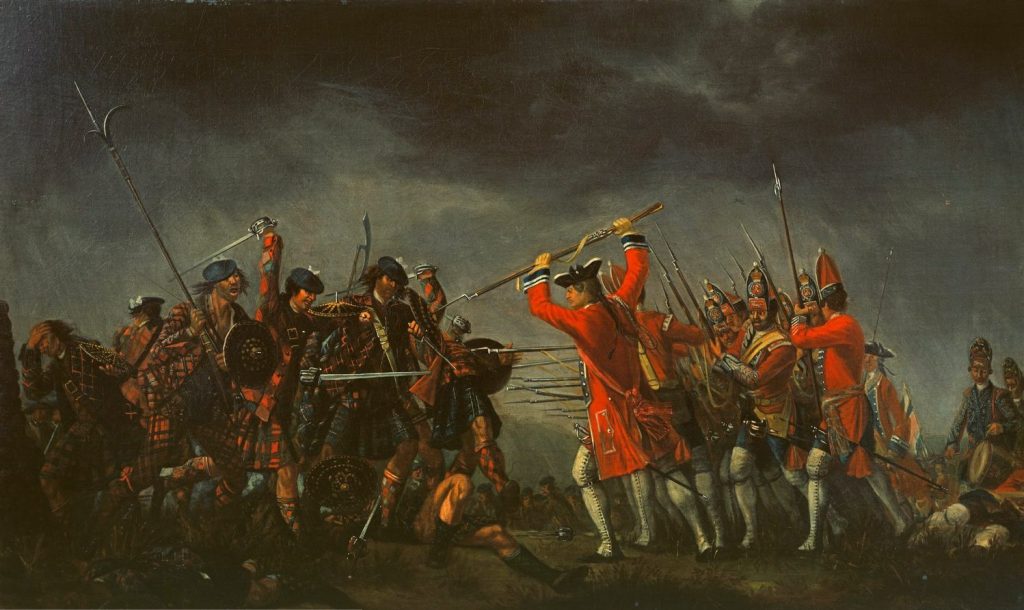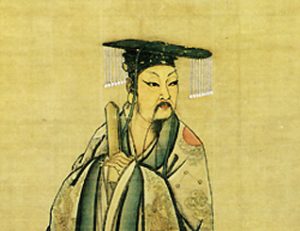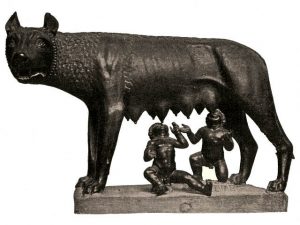The Scottish Jacobite Rising of 1745 occurred after decades of oppression and un-kept promises from the British Union. The Jacobites were a political movement in Great Britain and Ireland that wanted a Stuart restoration on the throne in London. The Stuarts’ role as the royal family of Great Britain had come to an end with the reign of King George I of Hanover in 1714, and the Jacobites were very much opposed to this departure from the Stuart dynasty. They were also unhappy at the neglect of a Scottish government by the leaders in London, and they were not happy with the power England was trying to assert over the Scottish.1 The Jacobite uprising started in the early seventeenth century and continued for over 170 years in which there were many changes to the throne that ultimately led to the two main Jacobite Rebellions of 1715 and 1745.
James IV, King of Scotland, rose to become the English King James I in 1603; this event marked the end of the Tudor dynasty and the origins of the Stuart dynasty. But the later problems of the Jacobite Risings also started here because King James’ focus left Scotland, and he started to push for the merging of Scotland, England, and Ireland. After James I death in 1625, his son King Charles I took the throne and continued his father’s policy of ignoring his family’s Scottish roots, which resulted in angering the Scottish people. After a few more deaths and subsequent changes in power, which did not go in favor of the Scots, the Jacobites formed to support James II, who followed his brother Charles II in 1685, and who was subsequently overthrown in 1688 for being openly Catholic in the majority Protestant country of England. The event became known as the “Glorious Revolution of 1688.” The word Jacobite actually comes from Jacobus, the Latin spelling of James. After being overthrown from power, James II was forced to go into exile in France, and the group of people who had overthrown James gave the crown to his Protestant daughter Mary and her husband William, of the Dutch House of Orange, who ruled until 1702. Following the death of William in the same year, Mary’s sister Anne was awarded the crown and was the leader who was in power when the agreement that joined England and Scotland was put in place; this union formed Great Britain.2

In 1714, when Queen Anne died without an heir to the throne, an act of Parliament forbade any Catholic from the throne, which meant that Sophia of the Palatinate would be the next in line to become Queen of Great Britain. However, she died before Queen Anne, so the throne was passed to her son Georg (George in English), Duke of Brunswick-Luneburg. King George I became the first Hanoverian King of England, and with King George, the reign of the Stuarts had come to an end. But the supporters of the Stuart line were not content to let things be. The first Jacobite Rebellion occurred immediately, in 1715.3
The rise to the throne of King George I angered many across Great Britain and even in parts of France. Also upset were the Scottish Highlanders, Catholics, and many aristocratic families who had remained loyal to the Stuarts because they were not happy to see Great Britain ruled by a foreigner; King George I did not even speak English. Many of the Highland clans and people from the northeast of Scotland supported the uprising due to their support of the Stuarts and their plans to rebuild its position as the Church of Scotland. Despite the strong support of the Highlanders and many people from parts of the Lowlands, there were several Scots that remained loyal to the Hanoverian Government, which led to this first Jacobite rising.4 The Jacobite Rebellion, however, was very unsuccessful. Under the command of the Earl of Mar, the Jacobites launched a careless attack in hopes of abolishing the rule of King George. After an initial success from the Jacobites, which attracted some support from outsiders, the Jacobites were defeated at the Battle of Preston in their march south to London.5 And thus ended the first of the Jacobite Rebellions.
Thirty years later, another Jacobite pursuit to overthrow the British throne occurred. In 1743, Charles Edward Stuart, better known as Bonnie Prince Charlie, plotted to invade Great Britain at a time that he thought was perfect for a rebellion. At the time, British forces had been sent to areas in Europe, while other soldiers were sent to America and the Caribbean. With this, Charlie was under the impression that the Brits would not expect a rebellion on their own shores.6 Charlie was also upset by France’s lack of invasion in 1744, which led to his decision to lead the Jacobites against the British Government once again.7

Charlie had built long distance relationships with people in the Scottish Highlands as well as with many among England’s Catholic population. In 1745, he arrived on the Scottish West Coast, where he immediately began recruiting for his rebellion. Within a month of being in the north of Scotland, the Bonnie Prince had raised the Jacobite standard and the rebellion had officially started. In mid-September Charlie had planned his invasion of England from Scotland, which was set to occur. On his journey south through Scotland, the Bonnie Prince faced his first test: the Battle of Preston Pans on September 20, 1745. Supported by his army of Highlanders, who were about 2,400 strong, he fought against the British army that outnumbered his forces. Despite the extra power of the British, the Jacobites were victorious and used this momentum to move into England.8
The Jacobites started strong on their march to London, successfully acquiring ammunition, arms, and horses on their journey south. As the Jacobites’ confidence grew, the mission at hand was becoming more and more of a reality, until King George II decided to recall his brother, the Duke of Cumberland, from France in an effort to prevent the rebellion from causing any long-term effects.9
The Bonnie Prince now found his army of Highlanders pursued by two armies: the Duke’s army and also the army of George Wade, who had decided to help the Duke’s efforts. This added support forced the Bonnie Prince to retreat to the safety of Scotland. By that time, the Jacobite army was exasperated, and faced a lack of food; they retreated to the Highlands. Just outside of Inverness, at Culloden Moor, the Jacobites made their last stand against the might of the British army.
The Battle of Culloden was nothing short of a slaughter of the Jacobites. The British army completely destroyed their enemy in a battle that lasted short of an hour. The superior artillery and manpower that the British had was enough to destroy the Jacobites, who were armed with very basic weapons such as blades and daggers.10

The Jacobites lost the majority of their men during the battle, while the British suffered about 15% of the casualties that the Jacobites did. Following the battle, the Duke’s men hunted down the remaining Jacobites and showed little mercy to the Highlanders. The Jacobites were either killed or imprisoned, with estates being destroyed, clans being broken up, as well as fine Highland traditions being banned. These repercussions destroyed the Highland culture and made it very difficult for the locals to return to what they had known before the rebellion took place.11
The power of the British was clear for all to see, and their presence was enough to take full control of Britain and prevent any further rebellions from the Jacobites. The British enforced the Heritable Jurisdictions Act of 1746, the Act of Proscription of 1746, and the Act of Indemnity of 1747. These acts stopped people that were connected with the uprising from returning to Scotland, as well as banning the use of traditional Highland dress.12
The fate of Bonnie Prince Charlie was a lot more peaceful than that of his army and their people. Charlie was able to flee from Culloden and remain in hiding on the Scottish Isles and Western Highlands before leaving for France. The Bonnie Prince’s escape is one of the most well-known stories in Scotland and people of all ages are accustomed with how he made it out alive but was forced to live the rest of his life in exile and in the safety of France. In the next decade, Charlie was even considered by the French foreign minister as someone who could help the French invade England, with the help of the Jacobites as well as a 100,000 strong army from France, during the Seven Years’ War; but he did not make a good enough impression with the minister, so the plan was dropped. Forty-two years after fleeing the Battle of Culloden, Charles died of a stroke in 1788 and was buried in the Vatican, and is now known by many as the last leader of the Jacobites.
- Encyclopedia Britannica, September 2007, s.v., “Jacobite.” ↵
- Encyclopedia Britannica, September 2007, s.v., “Jacobite.” ↵
- Encyclopedia Britannica, September 2007, s.v., “Jacobite.” ↵
- Encyclopedia Britannica, September 2007, s.v., “Jacobite.” ↵
- Encyclopedia Britannica, 2004, s.v., “Battle of Culloden.” ↵
- Encyclopedia Britannica, September 2007, s.v., “Jacobite.” ↵
- Encyclopedia Britannica, 2004, s.v., “Battle of Culloden.” ↵
- Encyclopedia Britannica, September 2007, s.v., “Jacobite.” ↵
- Encyclopedia Britannica, September 2007, s.v., “Jacobite.” ↵
- Encyclopedia Britannica, 2004, s.v., “Battle of Culloden.” ↵
- Encyclopedia Britannica, 2004, s.v., “Battle of Culloden.” ↵
- Robert Chalmers, History of the rebellion 1745-6 (W. & R. Chalmers, 1869), 307-310. ↵



7 comments
Madeline Emke
I really enjoyed the accuracy and succinctness of the article. I have watched nearly every episode of a show called Outlander, which focuses on a time traveler who falls in love with a Highlander in the 1700s. The show gives a similar description of the events of the Jacobite uprising as the article, which I really enjoyed because it meant that the show itself was relatively accurate in the historical perspective it was showcasing. I also loved how in-depth the author went into the history of both Jacobite rebellions and the outcomes of each rebellion as well.
Christopher Hohman
Nice article. I would like to note however, that it was King James VI not king James IV who became James I of England in 1603. The Jacobites were once a very powerful movement that could have had a very significant impact on the history of Great Britain. However, none of their rebellions were ever successful. If they had been then we might be looking at a completely different England than the one we have today.
Peter Coons
I have never before heard of the Jacobite uprising. To me, the only revolts in England during this time would be the various Highlander revolts. However, this paints a very different picture of the time and really instills the pride the Scotts had in their culture and battlefield prowess. To be able to best the strongest military in the world several times over is a feat not many can boast.
Tyler Sleeter
Great article! I had heard of the Jacobite rising, but did not really know what it was until reading your article. It was interesting to me that the clans of were able to ban together in an attempt to stop the rule of England over their country, unfortunately they did not succeed. However the people of Scotland were so determined, they tried it again, and failed again. I did not know the laws passed after the last uprising made traditional Scottish dress illegal. I am left wondering if it is on the record as still illegal or if a law has been written to overturn the old law.
Bailey Rider
This is an amazing article! I love learning about the Jacobite rebellion. It’s heartwarming that all of the clans could band together to try to beat the British and restore Charles Stewart to the throne. There’s a show called Outlander that focuses on the history of this and it’s super interesting, the history of it is amazing! Thank you for the great article!
Teresa Valdez
What a brave attempt by these people to gain a say in their leader. With Scotland being consumed by the British empire, it is understandable that they would feel helpless in their situation. I really liked how the article fleshed out the origins of the Jacobites, it made the reasons behind the rebellion easy to understand. It is upsetting that the British ultimately placed laws that restricted Scottish culture after the rebellion failed.
Mario De Leon
This was a great article. I like the picture the author chose to use as the featured image and I clicked on this article because of the picture. This article had a lot of information and I thought it was still well organized for all the information you had to fit into it. It is amazing how long this conflict lasted!